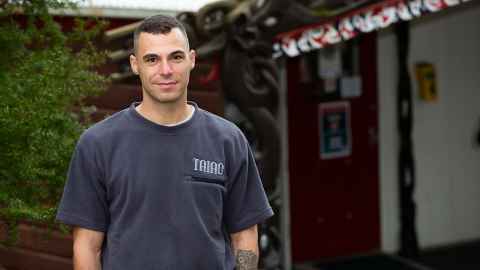Te Kapua O’Connor inspired by Māori ancestors
31 October 2022
PhD student Te Kapua O’Connor worked with mentors to transform his research on Māori ancestors into an accessible book. By Julianne Evans

Caught in a storm on his way from Hawaiki to Aotearoa, Ngāti Kurī navigator Pī spotted land behind him when all others were looking ahead and he cried to the captain: “E Pōhurihanga, kei muri kē te whenua, hurihia te waka.” (Pōhurihanga, the land we seek is behind us, turn the waka around!)
This story, says Te Kapua O’Connor, a Ngāti Kurī descendant in the second year of a Māori Studies PhD at Auckland, is a fitting metaphor for the value Māori place on kōrero tuku iho (histories), and of the past being inseparable from one’s identity and sense of self in the present.
It features in A Fire in the Belly of Hineāmaru: A Collection of Narratives About Te Tai Tokerau Tūpuna, 24 stories of Māori ancestors, from Te Hiku in the far north to Tāmaki Makaurau. It is co-authored by Te Kapua and Professor Melinda Webber, head of Te Puna Wananga at the Faculty of Education and Social Work, and translated into te reo Māori by Te Tai Tokerau language expert Quinton Hita.
“Melinda and I first worked together on the Starpath Project, which focused on Māori secondary student success,” says Te Kapua.
“We visited high schools in the north and their resounding message was: ‘We can achieve incredible things when we’re reminded that our tūpuna were incredible, and greatness when we know we descend from greatness’.”
He says while many ancestor stories exist, not many have been collected in an easily accessible book and, given that New Zealand history is now compulsory, teachers will be looking for resources.
“Melinda, like her ancestor, the eponymous Hineāmaru, is also a woman of action, securing a Marsden Fast-Start Grant and leading a kaupapa to feed tamariki, taiohi and their whānau with our histories,” he says.
Once they started looking, they found stories “everywhere and anywhere”, including in PhDs and other manuscripts.“But then we put another layer on top by talking to people and getting their interpretations.”
The project took shape thematically around the ancestors’ qualities, with headings like ‘peacemakers’, ‘entrepreneurs’ and ‘political leaders’.

I was surrounded by these great role models, and I also learnt how to engage with communities and research participants. It really does matter who you have in your corner.
There was a turning point in Te Kapua’s involvement after two years of full-time research.
“Melinda asked me to be co-author, to recognise ‘the immense work’ I’d put in, even though I was still in my mid-twenties when many are still growing the feathers required to fly like the proverbial manu.”
He believes his connection with leaders like Melinda and Dame Cindy Kiro, one of his masters supervisors, and Associate Professor Te Kawehau Hoskins (Pro Vice-Chancellor Māori), whom he met while training to be a teacher at Epsom, has made a vital difference to his success.
“I was surrounded by these great role models, and I also learnt how to engage with communities and research participants. It really does matter who you have in your corner.”
Once the material was gathered, the writing process involved intense periods of retreat in which Te Kapua and Melinda read aloud what they’d written. “We both have a background in academic writing. We wanted to make it engaging and entertaining for a general audience.”
Quinton Hita, who translated around 60,000 words, contributed his own refinements which influenced the English version, essentially making him the third author, says Te Kapua. And the work of renowned New Zealand artist Shane Cotton is featured on the cover of both books.
“It was important to us that the books be beautiful aesthetically; our people deserve no less. I still remembering gasping when I first saw what would become the cover painting. It was perfect.”
Now with the expertise of the Auckland University Press team and a mapmaker, the six-year project is finally complete, which Te Kapua says “feels a bit scary. Other people will have different perspectives. However, a supporter reminded us that without these projects, our histories will be lost, just like the moa, and that gave us the strength and confidence to continue.
“We have always positioned these books as a starting point in the ongoing journey to revitalise our Māori histories. We hope they plant a seed of inquiry in the young and old of Te Tai Tokerau to learn about who we are.”

This story is from the University of Auckland's alumni and friends publication Ingenio, Spring 2022 issue.
To republish in part or full, contact ingenio@auckland.ac.nz